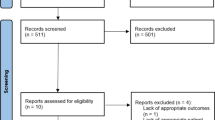Abstract
Background
Randomized controlled trials have shown that laparoscopic approach to surgery for perforated peptic ulcer (PPU) is associated with improved short-term outcomes; however, there is limited evidence concerning national practice. The aim of this investigation was to evaluate the effect of laparoscopic approach to PPU surgery upon mortality and morbidity in England.
Methods
Patients with a primary diagnosis of PPU, admitted as an emergency to a hospital in England, and receiving surgical intervention, between 2005 and 2012 were identified from the Hospital Episode Statistics database. Outcomes analyzed included 30-day and 90-day mortality, 30-day complications, and length of hospital stay. Univariate and multivariate analyses were used to identify patient, hospital, and treatment-related factors associated with use of laparoscopy and mortality.
Results
The study included 13,022 patients who underwent emergency surgery for PPU in England over an 8-year period. From 2005 to 2012, the utilization of laparoscopic surgery for PPU increased from 0 to 13% and was more commonly used in high volume emergency centers. Laparoscopic surgery was associated with significant reductions in 30-day (7% vs. 15.7%; P < 0.001) and 90-day mortality (8.9% vs. 19.6%; P < 0.001), pneumonia (6% vs. 10.1%; P < 0.001), ischemic cardiac events (1% vs. 2.4%; P = 0.007), as well as length of hospital stay (median 5 vs. 7 days; P < 0.001). Factors associated with a reduced utilization of laparoscopic surgery included age ≥ 70 years (Odds ratio (OR) = 0.58 (95% CI) 0.49–0.68) and Charlson Comorbidity Index score ≥ 2 (OR = 0.73; 95% CI 0.57–0.94).
Conclusion
The rate of laparoscopic repair of PPU is increasing at a national level and more common in high volume emergency centers. It is associated with reduced rates of mortality; pneumonia and shorter length of hospital stay, highlighting the need for strategies to improve dissemination of laparoscopic techniques necessary for PPU repair.

Similar content being viewed by others
References
Svanes C (2000) Trends in perforated peptic ulcer: incidence, etiology, treatment and prognosis. World J Surg 24:277–283
Soreide K, Thorsen K, Harrison EM, Bingener J, Moller MH, Ohene-Yeboah M, Soreide JA (2015) Perforated peptic ulcer. Lancet 386:1288–1298
Lunevicius R, Morkevicius M (2005) Management strategies, early results, benefits and risk factors of laparoscopic repair of perforated peptic ulcers. World J Surg 29:1299–1310
Mouret P, Francois Y, Vignal J, Barth X, Lombard-Platet R (1990) Laparoscopic treatment of perforated peptic ulcer. Br J Surg 77:1006
Lee FY, Leung KL, Lai BS, Ng SS, Dexter S, Lau WY (2001) Predicting mortality and morbidity of patients operated on for perforated peptic ulcers. Arch Surg 136:90–94
Lau WY, Leung KL, Kwong KH, Davey IC, Robertson C, Dawson JJ, Chung SC, Li AK (1996) A randomised control study comparing laparoscopic versus open repair of perforated peptic ulcer using suture or sutureless technique. Ann Surg 224:131–138
Bertleff MJ, Halm JA, Bemelman WA, van der Ham AC, van der Harst E, Oei HI, Smulders JF, Steyerberg EW, Langer JF (2009) Randomised clinical trial of laparoscopic versus open repair of the perforated peptic ulcer: the LAMA trial. World J Surg 33:1368–1373
Bertleff MJ, Lange JF (2010) Laparoscopic correction of perforated peptic ulcer: first choice? A review of literature. Surg Endosc 24:1231–1239
Lau H (2004) Laparoscopic repair of perorated peptic ulcer: a meta-analysis. Surg Endosc 18:1013–1021
Siu WT, Leong HT, Law BK, Chau CH, Li AC, Fung KH, Tai YP, Li MK (2002) Laparoscopic repair of perforated peptic ulcer: a randomised controlled trial. Ann Surg 235:313–319
Hospital Episode Statistics (HES). Welcome to HESonline. http://www.hscic.gov.uk/hes. Accessed 8 Jan 2017
Mackenzie H, Markar SR, Askari A, Ni M, Faiz O, Hanna GB (2016) National proficiency-gain curves for minimally invasive gastrointestinal cancer surgery. Br J Surg 103:88–96
Mamidanna R, Bottle A, Aylin P, Faiz O, Hanna GB (2012) Short-term outcomes following open versus minimally invasive esophagectomy for cancer in England: a population-based national study. Ann Surg 255:197–203
Markar SR, Mackenzie H, Wiggins T, Askari A, Ni M, Faiz O, Hanna GB (2015) Management and outcomes of esophageal perforation: a national study of 2,564 patients in England. Am J Gastroenterol 110:1559–1566
Markar SR, Mackenzie H, Huddy JR, Jamel S, Askari A, Faiz O, Hanna GB, Zaninotto G (2016) Practice patterns and outcomes after hospital admission with acute para-esophageal hernia in England. Ann Surg 264:854–861
Markar SR, Mackenzie H, Wiggins T, Askari A, Karthikesalingam A, Faiz O, Griffin SM, Birkmeyer JD, Hanna GB (2017). Influence of national centralization of esophago-gastric cancer upon management and clinical outcome from emergency upper gastro-intestinal conditions. Br J Surg. https://doi.org/10.1002/bjs.10640
Grailey K, Markar SR, Karthikesalingam A, Aboud R, Ziprin P, Faiz O (2013) Laparoscopic versus open colorectal resection in the elderly population. Surg Endosc 27:19–30
Southgate E, Vousden N, Karthikesalingam A, Markar SR, Black S, Zaidi A (2012) Laparoscopic vs open appendectomy in older patients. Arch Surg 147:557–562
Ates M, Sevil S, Bakircioglu E, Colak C (2007) Laparoscopic repair of peptic ulcer perforation without omental patch versus conventional open repair. J Laparoendosc Adv Surg Techn 17:615–619
Funding
Sheraz R. Markar is funded by the National Institute of Health Research (NIHR). The views expressed are those of the authors and not necessarily those of the NHS, the NIHR or the Department of Health.
Author information
Authors and Affiliations
Corresponding author
Ethics declarations
Disclosures
Dr Astrid Leusink, Dr Sheraz R. Markar, Dr Tom Wiggins, Dr Hugh Mackenzie, Dr Omar Faiz, Professor George B. Hanna have no conflicts of interest or financial ties to disclose.
Rights and permissions
About this article
Cite this article
Leusink, A., Markar, S.R., Wiggins, T. et al. Laparoscopic surgery for perforated peptic ulcer: an English national population-based cohort study. Surg Endosc 32, 3783–3788 (2018). https://doi.org/10.1007/s00464-018-6058-7
Received:
Accepted:
Published:
Issue Date:
DOI: https://doi.org/10.1007/s00464-018-6058-7




